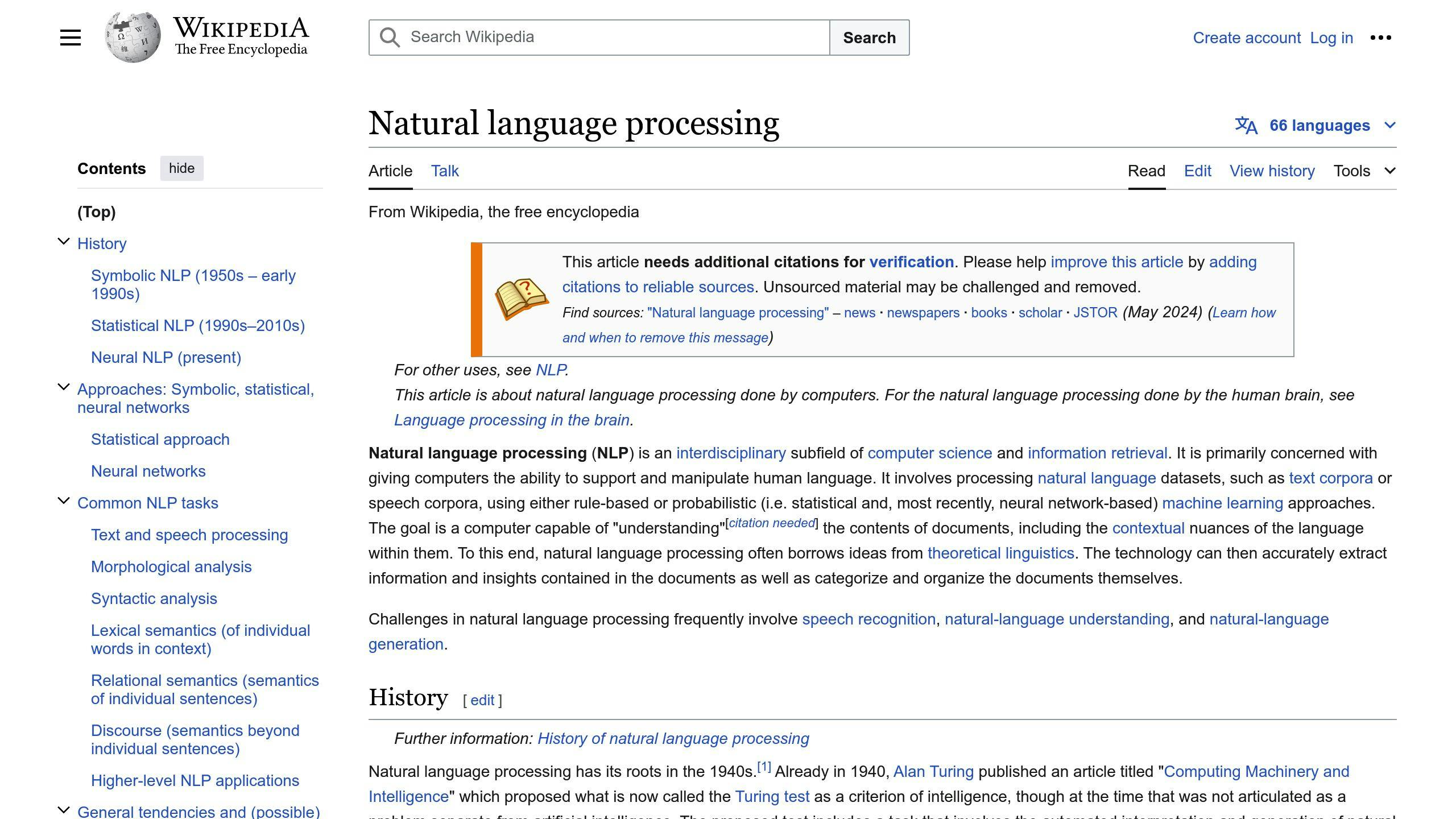Want to make your chatbot sound more human? Here are 10 key tips to improve your chatbot's conversational UX:
- Develop a distinct personality
- Use Natural Language Processing (NLP)
- Make chats flow naturally
- Give contextually relevant responses
- Handle errors smartly
- Use empathy and emotional intelligence
- Offer guided conversations
- Switch to human help when needed
- Use multiple communication modes
- Continuously improve
| Tip | Key Benefit |
|---|---|
| Distinct personality | Builds brand consistency |
| NLP | Understands user intent better |
| Natural flow | Creates more human-like interactions |
| Contextual responses | Provides more relevant answers |
| Smart error handling | Reduces user frustration |
| Empathy | Makes users feel understood |
| Guided conversations | Simplifies complex topics |
| Human handoff | Handles difficult issues |
| Multiple modes | Enhances engagement |
| Continuous improvement | Keeps chatbot up-to-date |
By applying these tips, you can create a chatbot that feels more natural to interact with, understands users better, and provides a smoother conversational experience. The key is to focus on making interactions feel human-like while leveraging AI capabilities.
Related video from YouTube
Why Human-Like Conversations Matter in Chatbot UX
Chatbots that talk like humans can make users happier and more engaged. This can lead to:
- More trust in your brand
- Loyal customers
- Better business results
Here's why human-like chats are important:
| Benefit | Description |
|---|---|
| Better user experience | Users feel more comfortable and understood |
| Faster problem-solving | Chatbots can grasp issues quickly and offer helpful solutions |
| Personalized service | Chats feel tailored to each user's needs |
| Continuous improvement | Chatbots learn from talks, getting better over time |
When chatbots understand and respond well, users feel heard. This can:
- Cut down on user frustration
- Make problem-solving easier
- Help users feel good about the interaction
Chatbots that talk like humans can also learn more about what users want. By looking at how people talk to them, chatbots can:
- Give better answers
- Offer more useful info
- Make chats flow more smoothly
Today, people want personal service. Chatbots that act human can give that. By adding things like:
- Understanding feelings
- Using humor when right
- Showing they care
Businesses can make chats more fun and helpful for users.
Next, we'll look at the first tip for making chatbots more human-like: giving them a clear personality.
1. Develop a Distinct Personality
Creating a clear personality for your chatbot helps make conversations feel more human-like. This can help users feel more at ease and understood.
Match Your Brand
Your chatbot's personality should fit your brand's style and values. This helps build trust with users. For example:
| Brand Style | Chatbot Personality |
|---|---|
| Funny | Uses jokes and puns |
| Professional | Formal and polite |
| Friendly | Casual and warm |
Understand User Needs
A good chatbot should grasp what users want and why they're asking. This lets the chatbot give answers that fit each user's needs. For instance:
| User Need | Chatbot Response |
|---|---|
| Help with a problem | Show empathy, offer solutions |
| Quick information | Give short, clear answers |
| Detailed explanation | Provide step-by-step guidance |
Talk Like a Person
To sound more human, chatbots should use everyday language. This means:
- Using common words
- Avoiding robot-like speech
- Adding personality to responses
For example:
| Robot-like | Human-like |
|---|---|
| "Your query has been processed." | "I've got that for you!" |
| "Negative." | "I'm afraid not." |
| "Please provide more information." | "Could you tell me a bit more?" |
2. Use Natural Language Processing (NLP)

Natural Language Processing (NLP) helps chatbots talk more like humans. It lets them understand and answer users better, making chats feel more real.
Understanding What Users Want
NLP helps chatbots figure out:
- What users are asking for
- The meaning behind their words
- How users feel
This means chatbots can give better answers that fit what users need.
Talking Like a Person
With NLP, chatbots can:
- Use everyday words
- Avoid sounding like robots
- Add some personality to their answers
This makes chats feel more natural and friendly.
Giving Personal Answers
NLP lets chatbots remember things about users and use this info to give better answers. This makes each chat feel more special to the user.
Fixing Mistakes
NLP helps chatbots spot and fix mistakes in what users say. This means they can:
- Clear up misunderstandings
- Ask for more info when needed
- Suggest helpful fixes
| What NLP Does | How It Helps |
|---|---|
| Understands user intent | Gives more accurate answers |
| Uses natural language | Makes chats feel more human |
| Remembers user info | Offers personal responses |
| Spots mistakes | Helps fix misunderstandings |
3. Make Chats Flow Naturally
To make chatbots talk more like humans, focus on how the chat flows. This helps make talks feel normal and keeps users interested.
Talk Like People Do
Make your chatbot sound like a real person:
| Do This | Don't Do This |
|---|---|
| Use everyday words | Use robot-like language |
| Take short breaks in the chat | Talk non-stop |
| Change tone based on the topic | Use the same tone for everything |
Get What Users Mean
The chatbot should understand what users want:
- Figure out why they're asking
- Remember what was said before
- Change answers based on the chat
Give Personal Answers
Make each chat feel special:
| How to Personalize | Example |
|---|---|
| Use the user's name | "Hi John, how can I help?" |
| Mention past chats | "Last time, you asked about shoes. Need more help with that?" |
| Offer answers that fit | "Since you like running, here are some good running shoes." |
4. Give Answers That Fit the Chat
To make your chatbot talk more like a person, it should understand what's going on in the chat and answer in a way that makes sense. This means the chatbot should remember what was said before and change its answers based on what the user wants and likes.
Get What the User Means
A good chatbot should figure out why the user is asking something. It should:
- Look at what the user said
- Find the main points
- Answer in a way that helps the user
For example, if someone asks about the weather, the chatbot should know they want to know what it's like outside right now and give them that info.
Talk Like People Do
The chatbot should also know how people usually talk. This means it should:
| What to Understand | How to Respond |
|---|---|
| Follow-up questions | Give more details |
| Jokes | Respond in a fun way |
| Upset users | Show care and help fix the problem |
By doing this, the chat will feel more normal and friendly.
Make Answers Just for the User
A good chatbot should give answers that fit each user. It can do this by:
- Using what it knows about the user
- Looking at what the user has done before
- Changing its answers to match what the user likes
For example, if a user has asked about sports before, the chatbot can talk about sports more often with that user.
| User Interest | Chatbot Action |
|---|---|
| Sports | Talk more about games and teams |
| Music | Suggest new songs or concerts |
| Food | Share recipes or restaurant tips |
This makes each chat feel special for the user.
5. Handle Errors Smartly
Ways to Deal with Errors
Good error handling in chatbots helps users feel less frustrated and more trusting. It keeps chats going smoothly. A good error system should:
- Tell users there's an error
- Explain what went wrong in simple words
- Help users fix the problem
Make Error Messages Sound Human
Error messages should be friendly and say sorry. This makes users feel understood. Don't blame users or use robot-like messages.
| Error Type | Robot-like Message | Human-like Message |
|---|---|---|
| Wrong Input | "Error: Wrong input" | "I'm not sure what you mean. Can you say that another way?" |
| System Problem | "System error. Try later." | "Sorry, we're having a problem. Can you try again in a few minutes?" |
Change Up Error Messages
Using different error messages helps chats feel more real. It stops users from getting bored or upset. By changing error messages, chatbots can:
- Keep chats interesting
- Show they care about the user's experience
Wrap-up
Smart error handling is key to making chatbots better. By telling users about errors, explaining problems, offering help, and using human-like messages, chatbots can build trust and keep users happy.
sbb-itb-bc761f5
6. Use Empathy and Emotional Intelligence
Chatbots that understand and respond to user feelings can make chats feel more human-like. This helps users feel heard and understood.
Spotting and Responding to Emotions
Good chatbots can tell how users feel by looking at what they say. They can then answer in a way that fits the user's mood. For example:
| User Feeling | Chatbot Response |
|---|---|
| Upset | "I'm sorry you're having trouble. Let's fix this together." |
| Happy | "That's great news! I'm glad to hear it." |
| Confused | "No worries, I can explain that better. What part is unclear?" |
Answers That Fit Each User
Chatbots can change how they talk based on how the user feels. This makes each chat feel more personal. Here's how:
| User Mood | How Chatbot Responds |
|---|---|
| Sad or Worried | Give kind words and offer help |
| Happy or Excited | Be upbeat and share in their joy |
| Angry | Stay calm and focus on fixing the problem |
7. Offer Guided Conversations
Guided conversations help chatbots talk more like humans. They make it easier for users to get help with tricky topics. This type of chat saves time and makes users happy.
How Guided Chats Work
Guided chats let users talk to the bot like they would with a person. This makes users feel at ease during the chat. It also stops them from getting lost or upset.
Keep Chats Clear
To make guided chats work well:
- Make the chat easy to follow
- Use short, clear messages
- Avoid confusing words
This helps the chat feel natural and quick.
Why Guided Chats Help
Guided chats are good for businesses and users. Here's why:
| For Business | For Users |
|---|---|
| Less work for staff | Get help faster |
| Happier customers | Easier to use |
| Fewer mistakes | Better answers |
8. Switch to Human Help When Needed
Chatbots should know when to let a real person take over. This keeps users happy and stops them from getting upset.
How to Hand Over to a Person
When a chatbot passes the chat to a person:
- Tell the user clearly that a person is taking over
- Give the user the name of the person helping them
- Explain why the chatbot is handing over
For example: "I can't help more with this, so John will take over now."
Keep Things the Same
The switch to a person should feel smooth:
| Chatbot | Human Helper |
|---|---|
| Uses the same tone | Keeps using the same tone |
| Talks like the brand | Also talks like the brand |
| Uses similar words | Uses similar words too |
This helps users feel okay with the change.
Know When to Get Help
Chatbots should know when to ask for human help:
- When the user's question is too hard
- If the user seems upset
- For topics that need a real person
To do this, chatbots can:
- Look at what the user is saying
- Check how the user feels
- Spot tricky topics
This helps make sure users get the right help when they need it.
9. Use Different Ways to Talk
Chatbots can talk to users in many ways, not just with words. This makes chats feel more like talking to a real person.
Pictures and Videos
Adding pictures, GIFs, and videos can make chats better. They help show things that are hard to explain with just words. For example:
| Chatbot Type | What It Can Show |
|---|---|
| Fashion | Pictures of clothes |
| Health | Videos of exercises |
Talk Like People Do
Chatbots should try to talk like real people. This means:
- Knowing how the user feels
- Changing how they talk based on the chat
- Remembering what was said before
For instance, if a user seems sad, the chatbot can be kinder in how it talks.
| User Feeling | How Chatbot Can Talk |
|---|---|
| Happy | Be cheerful too |
| Confused | Explain things slowly |
| Angry | Stay calm and try to help |
10. Always Get Better
To make a chatbot that talks like a person, you need to keep making it better. This means watching how it works, asking users what they think, and fixing how it understands and answers questions.
Check How Well It's Doing
To make your chatbot better, you need to change it over time. Here's how:
- Look at numbers that show how well it's doing
- Check things like how users rate chats and how long chats last
- This helps you see if your chatbot is doing a good job
Look at Chat Records
After each chat, save what was said. This helps you:
- Find problems users are having
- See where your chatbot needs help
- Teach your chatbot to do better next time
You can also see how many chats were good, okay, or bad.
Ask Users What They Think
It's important to know what users like or don't like about your chatbot. This helps you make it better. Here's why it's good:
| Benefit | How It Helps |
|---|---|
| Better understanding | Fix how the chatbot gets what users say |
| Better answers | Make the chatbot give better replies |
| Smoother talks | Make chats feel more natural |
Conclusion
Making a chatbot that talks like a person takes careful planning. By using these 10 tips, you can build a chatbot that users find easy and fun to talk to.
Here's a quick look at what matters most:
| Key Point | Why It's Important |
|---|---|
| Know your users | Helps you make a chatbot that fits their needs |
| Set clear goals | Keeps you on track when building your chatbot |
| Use the right tools | Makes it easier to create a good chatbot |
Remember:
- Try new things
- Ask users what they think
- Keep making your chatbot better
By doing these things, you can create a chatbot that:
- Understands users well
- Gives helpful answers
- Makes chats feel natural
Keep working on your chatbot over time. This will help you make it the best it can be for your users.
FAQs
How to make a chatbot more interactive?
To make your chatbot more engaging, focus on creating a good first impression and matching your business style. Here are some tips to boost interaction:
| Tip | Description |
|---|---|
| Use a friendly tone | Talk like a person, not a robot |
| Ask open questions | Get users to share more information |
| Give choices | Use buttons or menus for easy answers |
| Add fun elements | Include emojis and GIFs to show personality |
| Get user feedback | Let users rate their chat and suggest improvements |
When setting up your chatbot:
- Choose your welcome message carefully
- Decide if you want to sound formal or casual
- Think about what your users need



